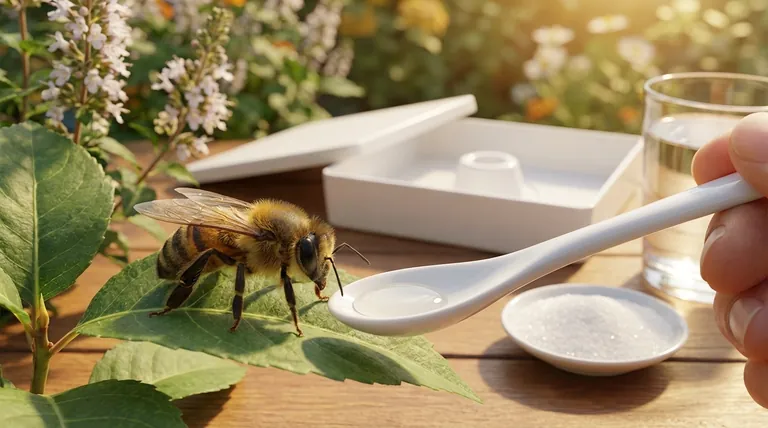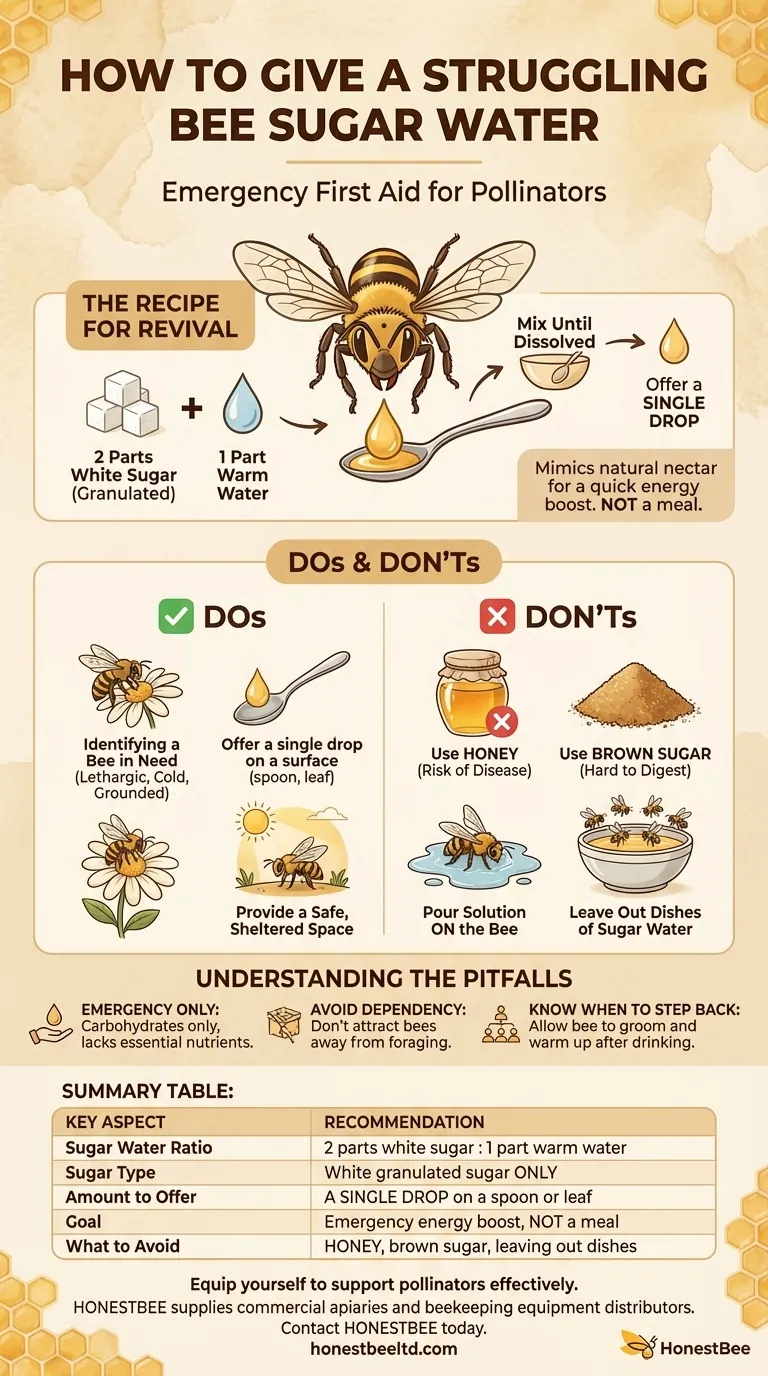To help a struggling bee, you should offer a solution made of two parts white granulated sugar to one part water. This high-energy mixture provides a quick boost, mimicking the composition of nectar and giving the bee the fuel it needs to fly again.
The goal is not to feed the bee, but to provide a one-time emergency energy source. This simple act of first aid can be lifesaving, but it's crucial to do it correctly to avoid causing unintentional harm.

Why the Specific Recipe Matters
A bee found on the ground is often suffering from exhaustion or cold, its energy reserves completely depleted. Your intervention is meant to bridge that energy gap, allowing it to return to its hive or continue foraging.
The Ideal Energy Source
The recommended ratio is two tablespoons of white sugar to one tablespoon of warm water. Mixing it with warm water helps the sugar dissolve completely, making it easier for the bee to ingest. This 2:1 ratio creates a solution that is calorically dense, similar to the nectar bees naturally seek from flowers.
Use Only White Granulated Sugar
It is critical to use only plain white granulated sugar. Do not use brown sugar, as its molasses content is difficult for bees to digest.
Never offer honey. While it seems natural, store-bought honey can contain spores of diseases like American Foulbrood, which are harmless to humans but fatal to bee larvae. If a foraging bee carries these spores back to its hive, it could decimate the entire colony.
The Right Way to Prepare It
Simply mix the two parts white sugar and one part warm water in a small container. Stir until the sugar crystals are fully dissolved. The solution should be offered at room temperature.
How to Help Without Causing Harm
Your method of delivery is just as important as the solution itself. A bee is a tiny, fragile creature that can be easily overwhelmed.
Identifying a Bee in Need
Look for a bee that is lethargic, not moving, or crawling on the ground far from any flowers. This is especially common on cool days or after a rainstorm. Do not assume every bee on the ground needs help; some are simply resting. A bee in genuine trouble will appear weak and unable to fly.
Offer, Don't Drown
Never pour the solution directly onto the bee. The bee can get stuck in the sticky liquid and drown.
Instead, place a single drop of the sugar water on a surface directly in front of the bee. A spoon, a leaf, or even the cap of a bottle works well. Allow the bee to approach and drink from the droplet on its own terms.
Provide a Safe Space
If the bee is in a high-traffic area, like a sidewalk, gently coax it onto a leaf or piece of paper and move it to a safer, sheltered location. Placing it on or near a flower is ideal, as this is its natural environment.
Understanding the Pitfalls
While your intention is to help, it's important to recognize that this is an emergency measure with potential downsides if done improperly.
This Is First Aid, Not a Meal
Sugar water provides carbohydrates for energy but lacks the essential proteins, vitamins, and minerals bees get from pollen and natural nectar. It is not a complete food source. This solution is purely for revival, not for sustained feeding.
Avoid Creating Dependency
You should never leave a dish of sugar water out in your garden. This can attract large numbers of bees away from their natural foraging duties, which disrupts pollination. It can also encourage bees from different hives to fight over the artificial food source, potentially spreading disease.
Know When to Step Back
After the bee has had a drink, it may need a few minutes to groom itself and warm up before it has the energy to fly away. Once you've provided the sugar water and moved it to safety, the best thing you can do is leave it alone.
Making the Right Choice for the Bee
Your goal is to provide a quick, effective boost that allows a bee to save itself.
- If you find a bee that seems tired and slow: Offer a single drop of a 2:1 white sugar and water solution on a spoon or leaf placed directly in front of it.
- If the bee is wet or cold from rain: Gently move it to a sunny, sheltered spot to warm up and dry off before offering any food.
- If you see a bee on the ground that seems otherwise healthy: Observe it for a few minutes, as it may just be resting between foraging trips.
By acting as a responsible and informed caretaker, you give a vital pollinator the best possible chance to survive.
Summary Table:
| Key Aspect | Recommendation |
|---|---|
| Sugar Water Ratio | 2 parts white sugar to 1 part warm water |
| Sugar Type | White granulated sugar only |
| Amount to Offer | A single drop on a spoon or leaf |
| Goal | Emergency energy boost, not a meal |
| What to Avoid | Honey, brown sugar, leaving out dishes of sugar water |
Equip yourself to support pollinators effectively. HONESTBEE supplies commercial apiaries and beekeeping equipment distributors with the high-quality, reliable supplies needed for healthy, productive hives. From feeders to protective gear, our wholesale-focused operations ensure you have the right tools for the job. Contact HONESTBEE today to discuss your beekeeping supply needs.
Visual Guide

Related Products
- HONESTBEE Professional Hive Top Bee Feeder Feeding Solution
- HONESTBEE Entrance Bee Feeder Professional Hive Nutrition Solution for Beekeeping
- HONESTBEE Round Hive Top Bee Feeder for Syrup
- HONESTBEE Advanced Ergonomic Stainless Steel Hive Tool for Beekeeping
- Professional Hive Front Entrance Bee Feeder
People Also Ask
- What features make top feeders a reliable choice for beekeepers? A Guide to Safe, Efficient Hive Nutrition
- What safety features are included in top feeders? A Guide to Drowning Prevention and Hive Safety
- How do I keep bees from drowning in my top feeder? Ensure Safe Feeding for Your Hive
- How is the plywood floor fitted into the hive-top feeder? Ensure Longevity with a Floating Floor Design
- What should be done with feeders and equipment after feeding bees? Essential Steps for Apiary Health



















